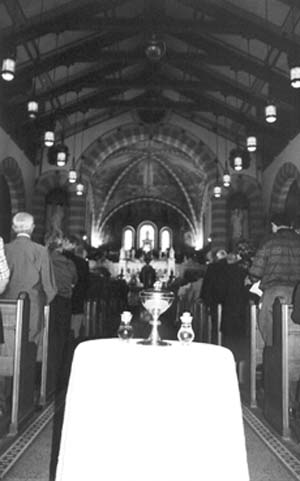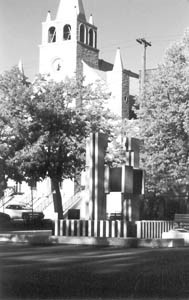|
|
| |
Founding
a Community:
The History of St. Anthony's Church
|
| By
Fiona Story |
|
The
stained-glass windows gleam in the soft light of the hanging
lanterns that overlook four long rows of shiny wooden pews.
It creates a solemn atmosphere of a village and its history.
Overlooking Piazza Dante,
St. Anthony's Church silently watches the community it has
shepherded for close to a century.
Between
1908 and 1913, the Italian community attended services in
a church on Murray Street before building St. Anthony's on
the corner of Booth, originally Division Street, and Gladstone,
known then as Pine Street.
"Saint
Anthony of Padua is very popular with Italians and highly
respected," said Father Marcel Brodeur, who has been
with the church for 12 years. He speaks of the church's namesake,
known as "the saint of miracles."
|
|
Named
after the Italian city he died in, and where his relics remain
to this day in the magnificent basilica Padua, St. Anthony was
actually born to an aristocratic family in Lisbon, Portugal.
This 13th century Franciscan monk was a gifted orator, who could
deliver his eloquent and fiery sermons in multiple languages,
and often attracted large crowds as he traveled around Italy.
Of his 56 accepted miracles only a few are believed to have
happened during his lifetime. One such miracle occurred when
he was offered poisoned food by some heretics, which he made
harmless by the sign of the cross.
Due
to the limited financial resources, Reverend Father Fortunatus,
the church's founder, could not construct a very large church
with the usual amount of art. As a result, the original version
of the church was three walls of brick and one wall of wood.
It had steep wooden stairs and a large basement used for gatherings.
|
 |
| St.
Anthony's, a "mother" watching over her community. |
|
|
Only
four years after its construction, the church fell victim to
a fire that caused around $3,000 worth of damages and the loss
of a Sacred Heart painting valued at $800. The fire is thought
to have started with lit candles at the altar. Flames had already
spread up the wall and were reaching towards the ceiling before
anything was noticed.
|
|
The
steady rise in the number of parishioners demanded an enlargement
of the church following the fire. Under the guidance of Guido
Nincheri, the renowned Italo-Canadian artist, the
church was remodeled. Nincheri's first suggestion was an excavation
of the basement. Following this, the wooden staircase was replaced
by a stone one. Nincheri went on to create vibrant stained-glass
windows and breathtaking frescoes for the church.
The
new church was inaugurated in November 1925.
|
|
However,
nearly four years later just after the celebration of the Birth
of Rome in April, a second fire broke out. It originated in
the vestibule and spread quickly up the tower and into the belfry.
Thousands gathered in the streets that night, thinking the entire
church was doomed but praying they were wrong. It survived but
the damages amounted to over $10,000. |
| "The
church is like foccolare, where people gather,"
said Father Brodeur. "I always say to children that
they have three homes. One is with your family, the other
with the school and the last with the church." |
|
Reconstruction
began immediately and every wooden part of the structure was
removed. The entire interior was replaced with reinforced
steel and cement. The ceiling and walls were finished in stucco
and the floor in terrazzo. Two galleries were constructed:
one for the choir and the organ and one for the congregation.
Both were made fireproof.
Considering
that the church already had a $45,000 debt, this level of
reconstruction inevitably added to that burden.
According
to Father Brodeur, the church has since gotten rid of its
debt load. Most was eliminated in the 1930's and 1940's under
Father Stefano Cheli.
|
|
Now,
standing firm for at least six decades, St. Anthony's is hailed
as the centre of the community it overlooks.
"As
far back as I can remember the church has been like a mother,"
said Mary Ierullo,
a longtime resident of the Italian community. "If we had
any problems, we always went to St. Anthony's."
The church plays a role in all major stages of a Catholic's
life: baptism, confirmation and communion, marriage and inevitably,
death. It is a place of worship and a focal point of activity.
"The church is like foccolare, where people
gather," said Father Brodeur. "I always say to children
that they have three homes. One is with your family, the other
with the school and the last with the church."
|
|
|
St.
Anthony's most active and arguably distressing period was in
the 1950's and 1960's. It was a time of great upheaval in the
community. There was a high level of immigration following the
Second World War and Father Jerome Ferraro, then parish priest,
was occupied helping immigrants find jobs and adapt to their
new homes.
It was also during this time that the homes of many Italian
families were expropriated. Properties in the Rochester/Gladstone
areas were expropriated to make room for Commerce High School
and the Rochester Housing Projects of the Ottawa Carleton
Regional Housing Authority, a move that many believe was influenced
by the politics of power.
"I
remember the church had to work hard to help people in the
community," said Ierullo, who's home was also expropriated.
"There were a lot of losses and the church had to work
hard to comfort people and help them." |
Many
Italians left the community but continue to return to the
church regardless of where they live now.
"Italians
have a strong family spirit," stated Father Brodeur.
"Their faith is very strong."
St. Anthony's Church is also closely connected with St.
Anthony's School. Both play a crucial role in
the education and support of the children in the community.
|
 |
| Inside
St. Anthony’s Church. |
|
St.
Anthony's is used not only for religious purposes but for
social activities as well. It is the meeting place for many
clubs and associations. The St. Anthony Italia Soccer Club
and the Italo-Canadian Senior Citizens Group had their origins
at the church. The church is also naturally the focal point
of feasts and celebrations. The
Feast
of St. Anthony, every second Sunday in June,
draws around 7,000 people with an additional 15,000 people
gathered along the streets for the procession.
"We are a family," stated Ierullo. "We uphold
each other and St. Anthony's has always been there."
It's likely it always will be.
|
|
|
| back
to the top |
|



